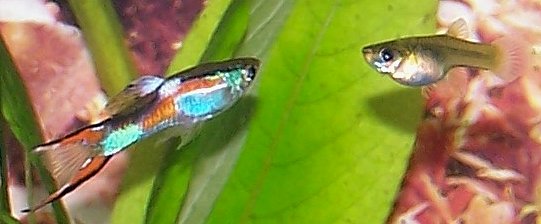- Poecilia wingei
Taxobox | name = Endler's livebearer or Endler's guppy

image_width = 250px
regnum =Animal ia
phylum = Chordata
classis =Actinopterygii
ordo =Cyprinodontiformes
familia =Poeciliidae
genus = "Poecilia "
species = "P. wingei"
binomial = "Poecilia wingei"
binomial_authority = Poeser, Kempkes, & Isbrücker, 2005"Poecilia wingei", known to aquarists as Endler's guppy or Endler's livebearer is a species of fish in the genus "
Poecilia ", native to the Paria Peninsula,Venezuela . [FishBase_species|genus=Poecilia|species=wingei|year=2007|month=April]History
"Poecilia wingei" is a colorful fish, similar to (and closely related to) the
guppy . The species was first collected from Laguna de Patos in Venezuela by Franklyn F. Bond in 1937, and rediscovered by Dr.John Endler in 1975. The latter were the first examples of this fish to make it to theaquarium trade. More have been collected since then, notably by Armando Pou, to expand the captive breeding stock. The original Laguna de Patos population is threatened by runoff from a municipal garbage dump. Though it is rare inpet shop s, this species is seen from time to time today in the aquaria of enthusiasts.I grew up in the southeast of Brazil far away from Venezuela and did quiet regularly collect them from the local rivers, therefore I think their range might be a lot bigger than previously thought!
Although not yet taken up into the
IUCN Red List of endangered species, they are in danger of extinction in the wild as humans enter their natural habitat, polluting and destroying it.Fact|date=June 2007In the Aquarium
Endler's livebearers are hardy and undemanding in the aquarium though they prefer hard, warm water. The warmer the water, the faster they will grow; however this also seems to shorten their lifespan. They can be kept at 18–29 °C (66–82 °F), but their optimum temperature seems to be 24–27 °C. This is slightly higher than their guppy cousins which prefer 23–25 °C. They do best if kept in tanks with plants (preferably live, but fake will do) to give them hiding places and (although they may be less likely than guppies to eat their own young) give the fry a better chance at survival. Some of them are determinedly suicidal jumpers, so a cover on the tank is a must.
Breeding
The colors of Endler's livebearers are very intense, especially the black, orange, and metallic green colors. Their natural patterns are highly variable, though many display a double sword tail. Breeders have developed numerous lines displaying specific patterns and colors, such as red chest, black bar, peacock, yellow sword, etc.
They are prolific breeders like their guppy relatives. They give birth to live young approximately every 28 days. The fry can be fed powdered fry food, baby brine shrimp, and crushed flake food. The will also nibble on the layer of algae and microorganisms that forms on aquatic plants. Even adult brine shrimp are not beyond their capability, as several fry will gang up on a brine shrimp their own size and tear it apart. The males will start to show color in 3-4 weeks, but it can be several months before they develop the full depth and richness of color that characterizes Endler's.
Hybrids
Endler's can be crossed with guppies and the hybrid offspring are fertile. This is considered to dilute the
gene pool and therefore is avoided by fish breeders who wish to maintain pure strains. Many fish sold in pet stores as Endler's livebearers are actually these hybrids. Some breeders are intentionally hybridizing Endler's with fancy guppies to create fish with the characteristics of both. In addition, as "reticulata" has been found in the same bodies of water as "wingei", it is possible that natural hybridization may also occur in the wild.References
External links
*cite journal | title = Description of "Poecilia" ("Acanthophacelus") "wingei" n. sp. from the Paria Peninsula, Venezuela, including notes on "Acanthophacelus" Eigenmann, 1907 and other subgenera of "Poecilia" Bloch and Schneider, 1801 (Teleostei, Cyprinodontiformes, Poecilidae) | journal = Contributions to Zoology | volume = 74 | year = 2005 | pages = 97–115 | author = Fred N. Poeser, Michael Kempkes, Isaac J. H. Isbrücker | url = http://www.goodeids.com/docs/POESER_2005_WINGEI.pdf
* [http://www.practicalfishkeeping.co.uk/pfk/pages/item.php?news=889 Clarke, Matt (2006) - Endler's livebearer gets formal name, Practical Fishkeeping magazine][http://www.indexpage.nl/endlers/ www.endlers.nl] Web-page about endlers, history and many other information (English)
Wikimedia Foundation. 2010.
